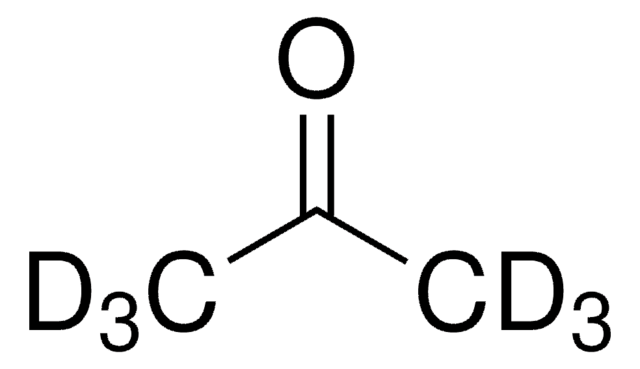17975
Ninhydrin reagent according to Stahl
for TLC derivatization
Sign Into View Organizational & Contract Pricing
All Photos(1)
About This Item
UNSPSC Code:
41116105
NACRES:
NA.22
Recommended Products
grade
for TLC derivatization
Quality Level
form
liquid
technique(s)
thin layer chromatography (TLC): suitable
impurities
1-butanol
acetic acid
density
0.823 g/mL at 20 °C
General description
Ninhydrin reagent is mostly used for the detection of amino acids. It basically gives a characteristic purple color on reaction with a-amino acids and other amino compounds, provided the pH of the reaction is 5.0 or higher. At an acid pH of 0.3, the reaction of ninhydrin with ornithinine and proline results in a red color product. Ninhydrin reagent can stay stable at room temperature in the absence of nitrogen atmosphere for upto 1 month in the ethylene glycol-sodium acetate solvent system.
Application
1 g ninhydrin dissolved in 475 mL 1-butanol and 25 mL acetic acid
Ninhydrin reagent may be used for the quantitative determination of total protein content in tissue hydrolysates.
Signal Word
Danger
Hazard Statements
Precautionary Statements
Hazard Classifications
Acute Tox. 4 Oral - Eye Dam. 1 - Flam. Liq. 3 - Skin Irrit. 2 - STOT SE 3
Target Organs
Central nervous system, Respiratory system
Storage Class Code
3 - Flammable liquids
WGK
WGK 2
Flash Point(F)
93.2 °F - closed cup
Flash Point(C)
34 °C - closed cup
Personal Protective Equipment
dust mask type N95 (US), Eyeshields, Gloves
Choose from one of the most recent versions:
Already Own This Product?
Find documentation for the products that you have recently purchased in the Document Library.
B Starcher
Analytical biochemistry, 292(1), 125-129 (2001-04-26)
Quantitation of small tissue samples for total protein content is essential for many biochemical analyses. In this study a ninhydrin method for measuring the total protein content of tissue hydrolysates is presented. The ninhydrin reagent is stable at room temperature
M K Gaitonde
The Biochemical journal, 104(2), 627-633 (1967-08-01)
1. An acid ninhydrin reagent was found to react specifically in forming a pink product (E(max.) 560mmu) with cysteine. 2. The method was highly sensitive for the determination of cysteine (in 28.0x10(3)). Homocysteine, glutathione, proline, ornithine and other naturally occurring
Sylvia Kristyanto et al.
Journal of microbiology (Seoul, Korea), 56(5), 317-323 (2018-05-04)
A novel, aerobic, Gram-stain-negative, non-motile, non-spore forming, rod-shaped bacterium, designated strain Dol 15-39T, was isolated from a seawater sample near Geoje Island in the South Sea, Republic of Korea. The strain was found to be oxidase-negative and catalase-positive. The isolate
Thin Layer Chromatography in Phytochemistry.
Hajnos WM
Science, 312-312 (2008)
Our team of scientists has experience in all areas of research including Life Science, Material Science, Chemical Synthesis, Chromatography, Analytical and many others.
Contact Technical Service










